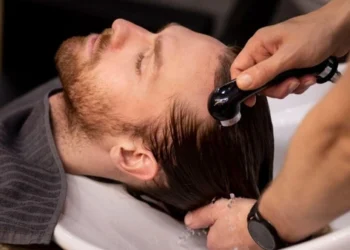For many men, the first signs of a receding hairline come as a surprise — that slightly higher forehead in photos, or hair that doesn’t quite fall the way it used to. At first, it’s easy to dismiss, but over time, thinning hair can affect confidence and how you present yourself to the world.
While styling tricks can help mask early hair loss, there comes a point where you may start wondering if it’s time to explore a more permanent solution — like a hair transplant.
Let’s explore what really works, what doesn’t, and how to make the best decision for your hair and confidence.
Understanding Hair Loss and Receding Hairlines
What Causes Hairlines to Recede?
The most common reason behind a receding hairline is androgenetic alopecia, often called male pattern baldness. It’s a hereditary condition influenced by hormones and genetics that causes hair follicles to shrink over time, leading to thinner and shorter strands.
Other factors can accelerate the process, such as:
- Stress and anxiety
- Nutritional deficiencies
- Smoking and poor lifestyle habits
- Hormonal imbalances
- Scalp conditions or certain medications
Early Signs You Might Notice
Hair loss typically begins at the temples or crown, forming the characteristic “M-shaped” hairline. Some early signs include:
- A widening part line
- More hair on your pillow or shower drain
- Difficulty achieving previous hairstyles
- Visible scalp under bright light
Recognizing these signs early gives you more options — from topical treatments to surgical solutions.
Hairstyles That Can Help Conceal Thinning Hair
1. The Short Textured Crop
This hairstyle adds texture and volume at the front, helping disguise a thinning hairline. It’s easy to maintain and ideal for men with early-stage hair loss.
2. The Side-Swept Fringe
A side-swept look can draw attention away from a receding temple area while framing the face naturally.
3. The Buzz Cut
For those ready to embrace a minimalist look, a buzz cut makes thinning less noticeable by reducing contrast between bald and non-bald areas.
4. The Modern Fade
A clean fade can balance proportions and create a stylish appearance that works with your natural growth pattern.
However, these styles can only do so much. As hair loss progresses, even the best haircut won’t hide a noticeably receding hairline.
When Hairstyles Aren’t Enough
It’s normal to feel frustrated when your styling options run out. If you’ve tried different cuts, hair fibers, or thickening products and still aren’t satisfied, it might be time to consider a medical solution.
Hair loss is progressive — meaning it will continue unless treated. That’s why more men today are choosing FUE (Follicular Unit Extraction) hair transplants as a long-term, natural-looking solution.
What Is a FUE Hair Transplant?
An FUE hair transplant involves extracting individual hair follicles (usually from the back or sides of the head) and implanting them into thinning or bald areas. Unlike older methods, FUE leaves minimal scarring, offers quick recovery, and delivers natural, lasting results.
Key Advantages of FUE:
- No visible linear scar
- Minimal discomfort during recovery
- Natural-looking results
- Permanent hair growth
- Suitable for both men and women
This method has become one of the most trusted and widely performed hair restoration procedures worldwide.
Why Choose Expert Clinics Like Fue India
When it comes to hair restoration, experience and precision make all the difference. Clinics such as Fue India specialize in advanced FUE procedures, using cutting-edge technology and meticulous techniques to deliver world-class results.
They focus on achieving a natural hairline that complements your facial structure, ensuring each follicle is placed at the correct angle and density. Whether you’re dealing with mild recession or advanced baldness, an expert FUE surgeon can create a customized plan that suits your goals and hair type.
The Hair Transplant Process: Step-by-Step
Step 1: Consultation and Assessment
A specialist evaluates your hair loss pattern, donor area, and overall scalp health. This step determines your eligibility for a transplant and helps set realistic expectations.
Step 2: Extraction
Individual hair follicles are carefully removed from the donor area using a micro-punch tool.
Step 3: Implantation
These follicles are then implanted into the thinning or bald regions in a pattern that mimics natural hair growth.
Step 4: Recovery and Growth
Most patients experience mild redness for a few days, but recovery is fast. New hair begins to grow naturally after 3–4 months, with full results visible within 9–12 months.
Life After a Hair Transplant
What to Expect During Recovery
After the procedure, you’ll receive aftercare instructions to ensure proper healing. Mild shedding is normal — it’s a natural part of the growth cycle.
Maintaining Your New Hair
Once transplanted, your hair will grow and behave just like the rest of your scalp hair. Regular washing, gentle products, and a balanced diet will help maintain thickness and strength.
Confidence Reborn
Most patients report a boost in self-esteem once they see their results. It’s not just about aesthetics — it’s about feeling like yourself again.
Non-Surgical Alternatives Before You Decide
Before committing to surgery, you may also explore non-surgical options such as:
- Minoxidil or Finasteride (FDA-approved treatments)
- Platelet-Rich Plasma (PRP) Therapy
- Laser therapy or scalp microneedling
- Improved diet and scalp massage
These can help slow hair loss in its early stages, but they’re typically less effective for advanced baldness.
Final Thoughts
Losing your hair doesn’t mean losing your confidence. Whether you’re just starting to notice thinning or already considering a hair transplant, understanding your options is key to taking control.
Modern FUE procedures, especially from trusted experts like Fue India Hair Transplant, make it possible to restore not only your hairline but also your sense of self-assurance.
Your journey to thicker, healthier hair begins with the right information — and the decision to take that next step.











